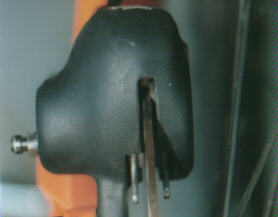Disk brakes use two metal-backed pads held in place by magnets. There may also be a spring-loaded clip that keeps the pads in place. Pistons push the pads against a metal rotor. Activation may be hydraulic, or with a standard brake cable. If you have mechanical disk brakes (activated with a cable), click here. If you have a hydraulic system without pad adjustment knobs, click here.
Proper function of the brake depends on (1) the rotor must be straight and smooth, (2) the caliper mechanism must be properly aligned with the rotor, (3) the pads must be positioned correctly, (4) there must be enough "pad" left, and (5) the lever mechanism must push the pads tightly against the rotor, with "lever" to spare.

Check the rotor itself for warp and damage. If the rotor wobbles, has "dings," or is severely worn, click here.
If your specific brake doesn't let you actually see the pads from outside the brake mechanism, you'll need to pull the pads out to check the wear.
To adjust the brake pads to compensate for wear (for example, when the brake lever is starting to come close to the handlebar), find the pad position adjuster. On the Coda brake pictured, the outer-side pad is moved inward by rotating the disk containing the oil valve with a hex wrench. On Avid brakes, there's a knob that you turn with your fingers.





Clean the interior of the brake mechanism with a Q-tip, removing all dirt, sand, and oil.


Now again adjust the brake pad position until you see both pads begin to approach the rotor, when sighting along the rotor into the brake mechanism.

Test the brake lever for the right amount of "pull" for your hand. Adjust this, not at the lever like ordinary brakes, but at the wheel, using the adjustment disk to move the pads towards or away from the disk.







